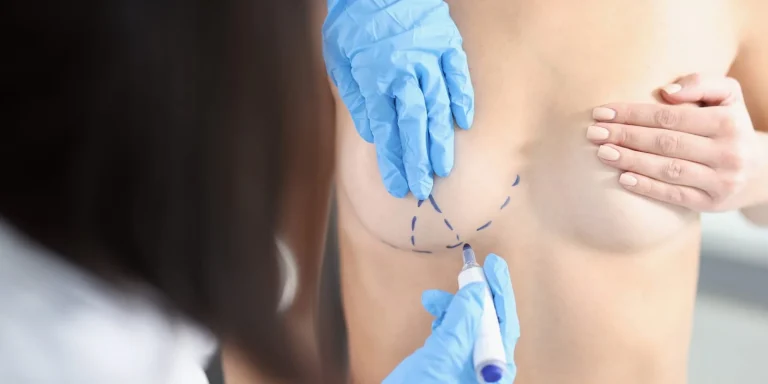If you’re considering a mastopexy (breast lift) procedure, it’s essential to know what to expect during your recovery and how to care for your breasts afterward. Understanding the recovery process can help ensure the best possible outcome and minimize any discomfort or complications.
In this article, we’ll guide you through the recovery process, explain how to care for your breasts after surgery, and provide insight into the cost and other considerations for your procedure.
"Beauty is the illumination of your soul."
John O’Donohue
Introduction to Mastopexy (Breast Lift)
Mastopexy, also known as a breast lift, is a cosmetic surgery designed to lift and reshape sagging breasts. This procedure is commonly performed to restore a youthful appearance to the breasts by removing excess skin and tightening the surrounding tissue. It can also be used to reposition the nipple and areola to a more natural, youthful position.
Common Reasons for Seeking a Mastopexy Lift
There are several reasons why individuals seek a mastopexy lift, including:
- Sagging due to aging: As you age, the skin loses elasticity, and breasts can begin to sag or lose their shape.
- Loss of volume after pregnancy: Pregnancy and breastfeeding can cause the breasts to stretch, lose volume, and sag.
- Weight changes: Significant weight loss or weight gain can affect the shape and firmness of the breasts.
- Genetics: Some people naturally have more ptotic (drooping) breasts, leading them to seek a mastopexy for improvement.
For those who want to address sagging and restore a more youthful breast appearance, augmentation and mastopexy may also be an option. This combined procedure involves both lifting the breasts and enhancing their volume through breast implants.
What Happens During the Mastopexy Procedure?
Overview of the Mastopexy Lift Procedure
During the procedure, the surgeon removes excess skin from the breast and tightens the surrounding tissue to create a firmer, lifted appearance. The size and location of the incisions vary depending on the degree of sagging and the desired result.
There are several techniques, but the most common involve an incision around the areola, with additional incisions extending vertically down the breast or along the breast fold.
What to Expect During Surgery
The mastopexy procedure is typically performed under general anesthesia, so you’ll be asleep throughout the surgery. The procedure can take between 1.5 and 3 hours, depending on the complexity of the surgery. The goal is to reshape the breast tissue, tighten the skin, and reposition the nipple and areola for a more youthful look.
In some cases, patients opt for a combined augmentation and mastopexy procedure if they desire both a lift and increased breast volume. This combination allows for a more significant change in breast shape and size in one surgery.
Mastopexy Recovery: What to Expect
Immediate Aftercare Following Surgery
After your procedure, you will be monitored in a recovery room for a few hours. You may experience some swelling, bruising, and discomfort, which are normal and will subside over time. Your surgeon will provide you with post-operative instructions, which may include wearing a surgical bra or compression garment to help support your breasts as they heal.
You’ll also be advised to rest and avoid any strenuous activities for the first few days to allow the healing process to begin.
Common Side Effects and Discomforts
During the first few days following the mastopexy lift, you may experience the following common side effects:
- Swelling and bruising: This is typical after any surgery and should subside within 1-2 weeks.
- Tenderness: Your breasts will likely feel sore, especially around the incision sites.
- Numbness: It’s not uncommon for the nipple and surrounding skin to feel numb or tingly, but this sensation usually resolves after several weeks.
The First Week of Recovery
During the first week of recovery, you’ll need to rest and avoid lifting heavy objects or engaging in any intense physical activity. You should also sleep on your back with your head elevated to reduce swelling. You’ll be instructed to avoid submerging your breasts in water, so no swimming or hot tubs during this time.
It’s important to follow your surgeon’s advice regarding when to return to work and resume normal activities. Most people can return to work within a week to 10 days, depending on the nature of their job and the level of physical activity required.

Long-Term Mastopexy Recovery
The Healing Process Over the Next Few Weeks
After the first week, you’ll gradually begin to feel better as swelling and bruising subside. You may still experience some mild discomfort, but it should decrease over time. Within 3-4 weeks, you’ll likely notice a significant improvement in the shape and appearance of your breasts, although full recovery can take several months.
Scarring and How to Minimize It
Scarring is a natural part of the recovery process, but the surgeon will place incisions in strategic areas to minimize visible scarring. In most cases, the scars will fade over time, but they may remain visible for a few months. The key to reducing scarring is following your surgeon’s aftercare instructions carefully, including keeping the incisions clean and avoiding sun exposure.
There are also topical treatments and silicone sheets that can help improve the appearance of scars over time. Always follow the advice of your surgeon for scar management.
Returning to Normal Activities
After 4-6 weeks, most patients can gradually return to their normal activities, including light exercise and regular daily tasks. However, it’s important to avoid strenuous activities, including heavy lifting or intense workouts, for several weeks to avoid disrupting the healing process. Your surgeon will provide specific instructions on when it’s safe to resume these activities.
Mastopexy Aftercare: How to Care for Your Breasts
Wearing a Surgical Bra and Support Garments
After the procedure, wearing a surgical bra or support garment is essential for providing the proper support as your breasts heal. These garments help reduce swelling, support the newly lifted breasts, and promote healing. You’ll typically wear them for several weeks after the surgery, especially while you sleep or during physical activities.
Managing Pain and Discomfort
Most people experience mild to moderate discomfort during the recovery process. Your surgeon may prescribe pain medication to help manage any pain. Over-the-counter pain relievers like ibuprofen can also help with inflammation and discomfort. Be sure to follow your surgeon’s recommendations regarding pain management.
Avoiding Complications and Keeping an Eye on Your Recovery
While complications are rare, it’s essential to monitor your breasts during the recovery process. Look for signs of infection, such as increased redness, swelling, or drainage from the incisions. If you experience any unusual symptoms, contact your surgeon immediately.
Be sure to attend follow-up appointments as scheduled so your surgeon can assess your recovery progress and address any concerns.

Mastopexy Cost: What You Need to Know
Average Mastopexy Cost
The cost of a mastopexy lift can vary widely depending on several factors, including the surgeon’s experience, the complexity of the procedure, and the location of the clinic. On average, the cost can range from $4,000 to $10,000. If you’re combining a lift with breast augmentation (augmentation and mastopexy), the price will be higher, typically ranging from $7,000 to $15,000 or more.
Does Insurance Cover Mastopexy?
Since it is considered a cosmetic surgery, most insurance plans do not cover the procedure. However, if the breast sagging is causing physical discomfort or medical issues (such as back pain), some insurance providers may offer partial coverage. It’s essential to check with your insurance provider to see if you qualify for coverage.
Payment Options and Financing
Many clinics offer financing options to help make the procedure more affordable. Payment plans allow you to spread the cost of the surgery over time, making it easier to fit the procedure into your budget. Be sure to inquire about financing options during your consultation.
When to Expect the Final, Settled Look of Your Breasts After Full Recovery
After the initial healing period, it can take several months for the full results of your mastopexy to become apparent. Your breasts will gradually settle into their new position, and the swelling will continue to subside. Full results are typically visible after about 6 months to 1 year, although some minor changes may occur over time.
It’s important to maintain realistic expectations and give your body time to heal correctly. Keep in mind that every patient’s recovery process is different, and the timeline may vary depending on individual factors like skin type, age, and overall health.
Personalized Consultation and Professional Experience
When considering mastopexy, it’s essential to choose a qualified and experienced surgeon who can guide you through the process and help you achieve the best possible results. A thorough consultation will help you understand the procedure, recovery expectations, and costs associated with your surgery. Don’t hesitate to ask questions about the surgeon’s experience, the techniques they use, and the expected outcomes.
By following your surgeon’s aftercare instructions and maintaining realistic expectations, you can achieve beautiful, natural-looking results that enhance your appearance and boost your confidence.

